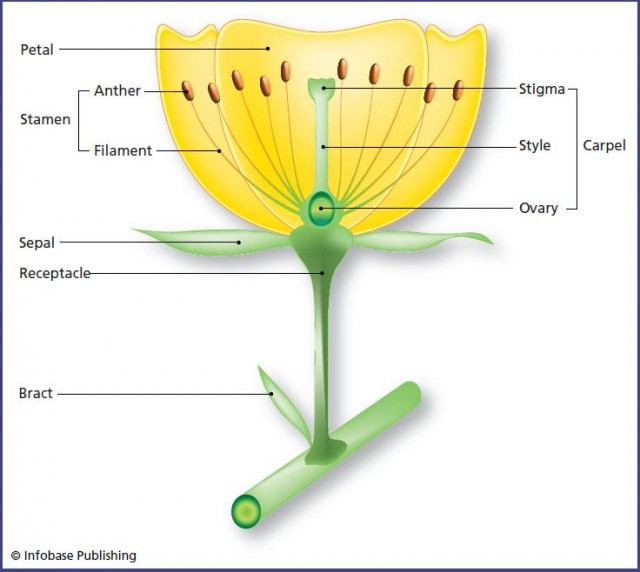Joseph Pitton de Tournefort and the Grouping of Plants
Its flower is the most obvious feature of most flowering plants. Many flowers have brightly colored petals. These attract pollinating animals. Plants such as grasses that are pollinated by wind have no need of petals, so their flowers are usually smaller and drab in color, but they are nevertheless prominent and clearly visible. However it is pollinated, the flower is the plant's reproductive structure, containing either male organs or female organs or both. The following illustration shows an idealized flower, with petals and both male and female reproductive organs. A flower of this type is said to be perfect. Flowers with only stamens—male reproductive organs—are said to be staminate, and flowers with only carpels—female reproductive organs—are carpellate. Staminate and carpellate flowers are described as imperfect. In addition, the flower in the illustration has both petals and sepals—leaflike structures that together formed the calyx that enclosed and protected the flower bud. The possession of petals and sepals makes the flower complete. An incomplete flower lacks either petals or sepals or both.
When botanists set about classifying plants and teaching their students techniques for identifying them, it is not surprising that they first concentrated on the flowers. In 1694 the French botanist Joseph Pitton de Tournefort (1656–1708) published a guide to plant recognition based on flower structure that prepared the way for Linnaeus to develop his classification system. The guide was entitled (in the original 17th-century French) Elemens de botanique, ou Methode pour connoitre les Plantes (Elements of botany, or method for recognizing plants). Tournefort wrote in French, and in 1700 the work was translated into Latin with the title Institutiones rei herbariae, with a second edition published in 1719. The French edition contained 451 plates of illustrations and the Latin translation had 476. In 1703 a supplement was published with an additional 13 plates. The work had three volumes, the first containing the text and the remaining two containing the illustrations.

Tournefort included a description of fungi and classified lichens as a group distinct from plants. Fungi were long thought to be plants, but are nowadays recognized as belonging in a separate taxonomic kingdom. A lichen is a composite organism consisting of a fungus together with an alga—a simple plantlike organism that is not differentiated into roots, stems, and leaves—or a cyanobacterium—a bacterium that performs photosynthesis. Tournefort based his key to plant identification on the form of the corolla—the structure formed by all the petals. In other words, he taught his students to recognize plants by the outward appearance of their flowers. On this basis, he grouped plants into 22 classes, but then used other characteristics such as the shape of the fruit and seed to divide the classes into sections and genera. His method was easy to use, because flowers vary greatly. More important, however, Tournefort was the first botanist to make a clear distinction between species and genus. His Elemens de botanique described approximately 7,000 plants and he was able to arrange these into about 700 genera. Linnaeus used many of the generic and specific names Tournefort introduced. At higher taxonomic levels, however, Tournefort continued the old practice of designating plants as trees, shrubs, or herbs.
Simple though Tournefort's system was, it had two major drawbacks. The first and most obvious was that only flowering plants can have a corolla, and even then wind-pollinated plants have flowers lacking petals. Coniferous plants such as pines, spruces, firs, redwoods, and junipers produce male and female cones. These are colored in some species, but they are not true flowers, and they have no petals. So entire groups of plants remained outside the system. The second drawback was more subtle, but no less serious. Tournefort's system was artificial. Related species often have very similar flowers but not always, and two species with similar flowers may be related only distantly or not at all. The structure of their flowers has no bearing on the relationship between species.
Joseph Pitton de Tournefort was born on June 5, 1656, in Aix-en-Provence in southern France. He commenced his education at the Jesuit seminary in Aix, where he studied theology with the intention of entering the church, but after his father's death he turned to botany and spent two years collecting plants before studying medicine at the universities of Montpellier and Barcelona. In 1683 he was appointed director and professor of botany at the Jardin du Roi in Paris, a position that allowed him to travel extensively in southern Europe on behalf of the king, who instructed him to check the accuracy of maps and to observe conditions in the countries he visited, traveling as much as possible overland rather than by sea. Between April 1701 and June 1702, Tournefort passed through the Greek islands on his way to visit Constantinople (modern Istanbul) and the lands bordering the Black Sea, including Armenia and Georgia and extending to the Persian (Iranian) frontier. He collected plants on all his travels, and during his journey to the east he collected specimens of 1,356 species. His account of his travels was published posthumously in 1717 as Relation d'un voyage du Levant (Account of a journey in the Levant). He was elected a member of the Academy of Sciences in 1692.
Tournefort qualified as a doctor of medicine in 1698, and in 1702 he became professor of medicine at the College de France. Tournefort died in Paris on December 28, 1708, in an accident with a carriage on the street that is now called the rue de Tournefort.
- Jose Mutis and the Bogota Botanical Garden
- Jean-Baptiste Lamarck and the Royal Garden, Paris
- Sir William Hooker, the First Official Director
- Sir Joseph Banks, Unofficial Director of Kew
- Sir Henry Capel, Princess Augusta, and the Royal Botanic Gardens at Kew
- Tulipomania
- Carolus Clusius, the Leiden Botanical Garden, and the Tulip
- Pisa, Padua, and Florence, the First Botanical Gardens
- The Rise of the Herbarium